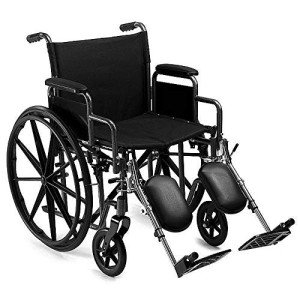Bariatric Wheelchair Seat Width
Seat Width
Having the appropriate seat width is essential to wheelchair users who spend longer periods in their chairs. Too narrow a seat will cause pressure on the hips and thighs which might lead to sores or pressure points. Having too wide a seat can likewise make it difficult for the user to reach the hand rims to move themselves or maneuver in small areas.
To determine the correct seat width an individual would rest on a chair usually and have their measurement taken throughout their lap at the widest point which is normally their hips. A wheelchair measuring tape can be utilized to determine this, but a backyard stick is chosen as it avoids people from covering the tape around their hips which would give an inaccurate outcome.
The basic wheelchair seat width is 16" (narrow grownup), 18" (basic adult), and 20" (broad grownup). For bariatric clients, a 24" seat is offered. This sturdy extra wide bariatric wheelchair from Medline features swing-away footrests, a carbon steel frame with rust- and chip-resistant chrome plating, and easy-to-clean vinyl upholstery. It has a weight capacity of 500 pounds.
Seat Depth

Generally, the seat depth of a bariatric wheelchair was added 2" to the measurement taken at the user's best point (usually their hips). This was suggested to accommodate extra layers of clothing that may be used throughout cold weather condition. However, this practice is becoming less common as wheelchair users have the ability to spend more time inside and are not wearing long coats. This makes the seat depth of a chair lesser when choosing a bariatric wheelchair. Nevertheless, it is still crucial to pick an alternative that uses appropriate assistance for larger users.
The Medline folding additional large bariatric manual wheelchair includes a comfy 24" seat width and a durable slide tube silver vein frame. It also has an adjustable axle and tool-free elevating legrests.
Seat Height
When it comes to determining the appropriate wheelchair seat width you should constantly measure from the user's widest point which is usually their hips. You will also need to think about whether the user is going to be using a winter season coat as this may include 2" to the width required.
When a wheelchair is in usage it need to just be run on level surfaces with the wheel locks fully engaged. This is to prevent the chair from having the ability to move slopes that are 10 degrees or greater. It is likewise essential to bear in mind that any activity that might shift the center of gravity in the chair ought to be made with care. This includes reaching for items that require the person to lean out of their seat or trying to stand up from it.
Whenever you have the chair in usage it is advised that you regularly check it for damage and oil any locations that are deemed needed. For instance, the casters should be lubed by removing the caster fork and using a multi-purpose grease to apply to the caster stem bearings. Likewise, the foot plates can be changed by loosening the bolt and after that moving them to the wanted position. This allows the feet to sit conveniently on the footplate and avoids any pressure points from forming. This can be really unpleasant for the user and if left ignored, can lead to push sores.
Weight Capacity
Bariatric wheelchairs are designed to support more weight than basic wheelchairs. This makes them tougher and better equipped to deal with falls. They are also typically bigger and wider, making them less maneuverable in tight spaces than basic wheelchairs. They require lorries with unique ramps and lifts to fill them, along with chauffeurs who understand how to finest transport them from one place to the next.
When choosing a wheelchair, consider its weight capacity as it will be the main determining element in whether it will accommodate your passenger's requirements. The weight capacity of the chair is often listed as a fixed load, suggesting that it indicates the amount of weight the chair can conveniently hold while stalling. However, some manufacturers also list an active load that is based upon a drop test and can simulate the effect of somebody sitting down in the chair. This might be a more trusted measurement of the weight limit, depending on your needs.
If you prepare to carry out activities that move your center of gravity in the seat (such as reaching for things), be sure to have front casters pointed in a forward direction and wheel locks engaged so the chair will not topple. Likewise, inspect that click over here now are lubricated regularly to prevent extreme wear and abrasions. The lubrication treatment involves getting rid of the fork, separating the caster from the wheel, and greasing the caster stem bearings with premium multi-purpose grease.
